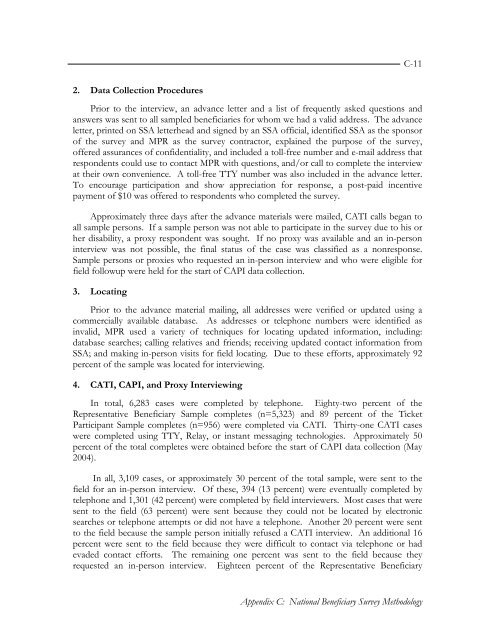Evaluation of the Ticket to Work Program, Implementation ...
Evaluation of the Ticket to Work Program, Implementation ...
Evaluation of the Ticket to Work Program, Implementation ...
You also want an ePaper? Increase the reach of your titles
YUMPU automatically turns print PDFs into web optimized ePapers that Google loves.
C-112. Data Collection ProceduresPrior <strong>to</strong> <strong>the</strong> interview, an advance letter and a list <strong>of</strong> frequently asked questions andanswers was sent <strong>to</strong> all sampled beneficiaries for whom we had a valid address. The advanceletter, printed on SSA letterhead and signed by an SSA <strong>of</strong>ficial, identified SSA as <strong>the</strong> sponsor<strong>of</strong> <strong>the</strong> survey and MPR as <strong>the</strong> survey contrac<strong>to</strong>r, explained <strong>the</strong> purpose <strong>of</strong> <strong>the</strong> survey,<strong>of</strong>fered assurances <strong>of</strong> confidentiality, and included a <strong>to</strong>ll-free number and e-mail address thatrespondents could use <strong>to</strong> contact MPR with questions, and/or call <strong>to</strong> complete <strong>the</strong> interviewat <strong>the</strong>ir own convenience. A <strong>to</strong>ll-free TTY number was also included in <strong>the</strong> advance letter.To encourage participation and show appreciation for response, a post-paid incentivepayment <strong>of</strong> $10 was <strong>of</strong>fered <strong>to</strong> respondents who completed <strong>the</strong> survey.Approximately three days after <strong>the</strong> advance materials were mailed, CATI calls began <strong>to</strong>all sample persons. If a sample person was not able <strong>to</strong> participate in <strong>the</strong> survey due <strong>to</strong> his orher disability, a proxy respondent was sought. If no proxy was available and an in-personinterview was not possible, <strong>the</strong> final status <strong>of</strong> <strong>the</strong> case was classified as a nonresponse.Sample persons or proxies who requested an in-person interview and who were eligible forfield followup were held for <strong>the</strong> start <strong>of</strong> CAPI data collection.3. LocatingPrior <strong>to</strong> <strong>the</strong> advance material mailing, all addresses were verified or updated using acommercially available database. As addresses or telephone numbers were identified asinvalid, MPR used a variety <strong>of</strong> techniques for locating updated information, including:database searches; calling relatives and friends; receiving updated contact information fromSSA; and making in-person visits for field locating. Due <strong>to</strong> <strong>the</strong>se efforts, approximately 92percent <strong>of</strong> <strong>the</strong> sample was located for interviewing.4. CATI, CAPI, and Proxy InterviewingIn <strong>to</strong>tal, 6,283 cases were completed by telephone. Eighty-two percent <strong>of</strong> <strong>the</strong>Representative Beneficiary Sample completes (n=5,323) and 89 percent <strong>of</strong> <strong>the</strong> <strong>Ticket</strong>Participant Sample completes (n=956) were completed via CATI. Thirty-one CATI caseswere completed using TTY, Relay, or instant messaging technologies. Approximately 50percent <strong>of</strong> <strong>the</strong> <strong>to</strong>tal completes were obtained before <strong>the</strong> start <strong>of</strong> CAPI data collection (May2004).In all, 3,109 cases, or approximately 30 percent <strong>of</strong> <strong>the</strong> <strong>to</strong>tal sample, were sent <strong>to</strong> <strong>the</strong>field for an in-person interview. Of <strong>the</strong>se, 394 (13 percent) were eventually completed bytelephone and 1,301 (42 percent) were completed by field interviewers. Most cases that weresent <strong>to</strong> <strong>the</strong> field (63 percent) were sent because <strong>the</strong>y could not be located by electronicsearches or telephone attempts or did not have a telephone. Ano<strong>the</strong>r 20 percent were sent<strong>to</strong> <strong>the</strong> field because <strong>the</strong> sample person initially refused a CATI interview. An additional 16percent were sent <strong>to</strong> <strong>the</strong> field because <strong>the</strong>y were difficult <strong>to</strong> contact via telephone or hadevaded contact efforts. The remaining one percent was sent <strong>to</strong> <strong>the</strong> field because <strong>the</strong>yrequested an in-person interview. Eighteen percent <strong>of</strong> <strong>the</strong> Representative BeneficiaryAppendix C: National Beneficiary Survey Methodology
















